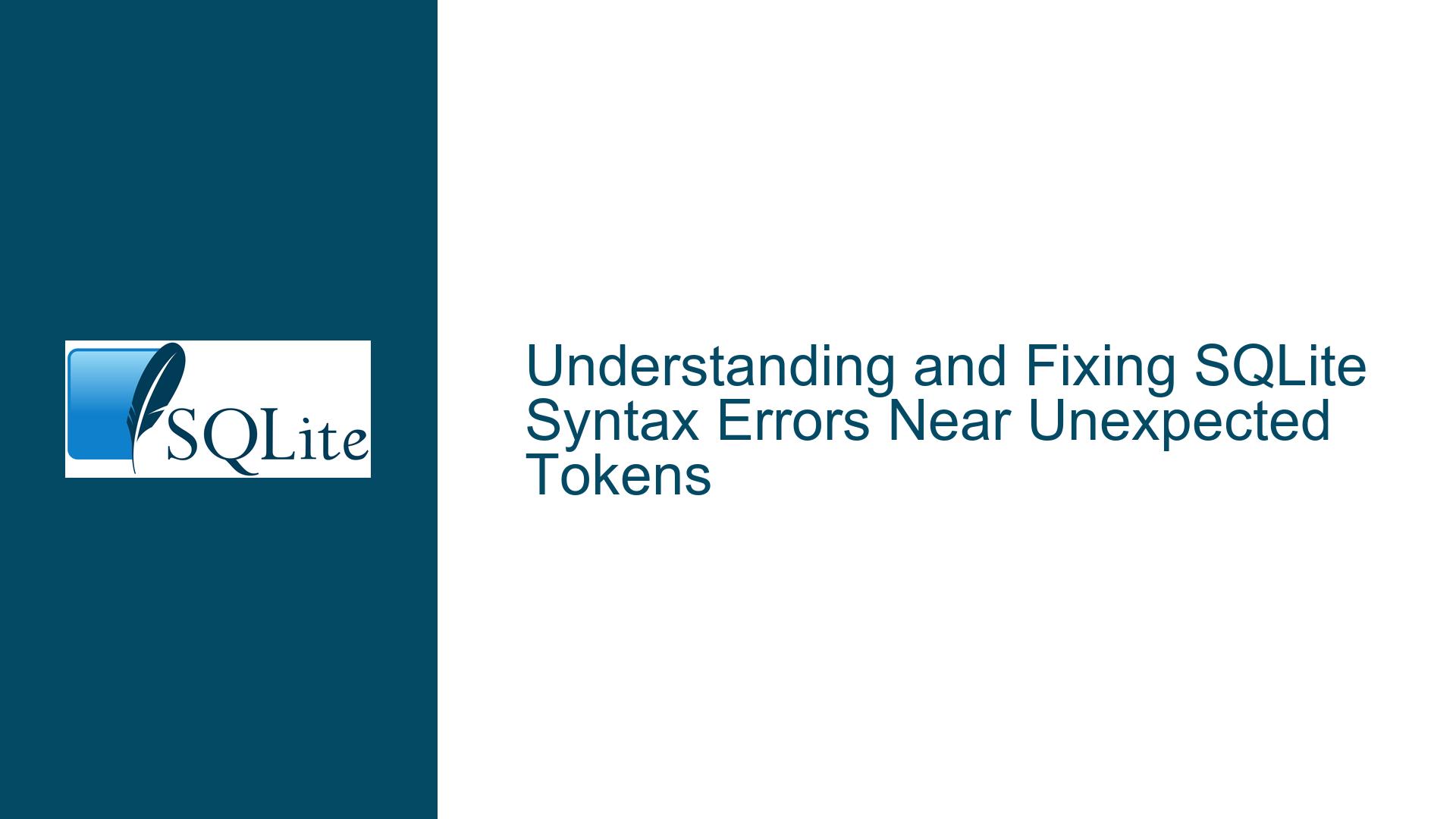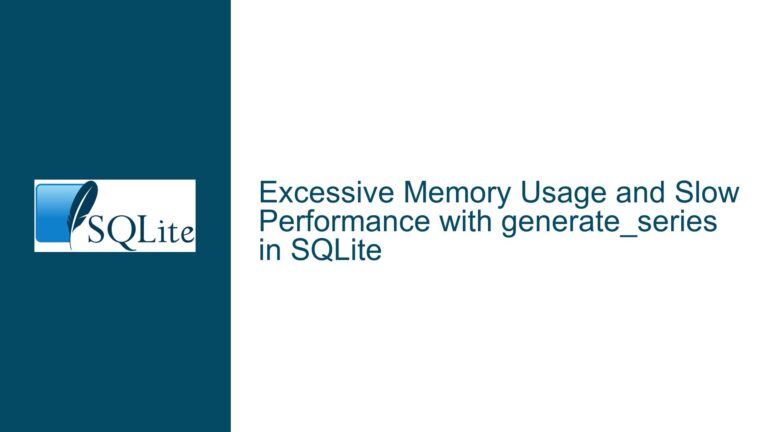and Fixing SQLite Syntax Errors Near Unexpected Tokens
Issue Overview: Syntax Errors in SQLite Due to Incorrect File Execution
When working with SQLite, one of the most common issues that users encounter is syntax errors, particularly those that occur near unexpected tokens. These errors can be frustrating, especially when they seem to arise from seemingly correct commands. A typical scenario involves attempting to execute SQL commands from a file directly within the SQLite shell, leading to an error message that points to a syntax error near a specific token, often the first character of the file path or command.
In the provided discussion, the user attempted to execute a SQL script file by directly typing the file path into the SQLite shell, resulting in a syntax error near the "c" character. This error occurs because SQLite interprets the file path as part of a SQL statement rather than a command to read and execute the file’s contents. SQLite’s error reporting mechanism, while helpful, is limited in its ability to provide detailed context about the nature of the error, often only indicating the token near which the error was detected.
Possible Causes: Misinterpretation of File Paths and Command Syntax
The root cause of this issue lies in the misinterpretation of the file path as a SQL statement. SQLite’s command-line interface (CLI) is designed to accept SQL commands directly. When a user inputs a file path directly into the shell, SQLite attempts to parse it as a SQL statement, leading to a syntax error. This is because file paths, especially those containing special characters like colons and slashes, do not conform to SQL syntax rules.
Another contributing factor is the lack of awareness about the .read command, which is specifically designed to read and execute SQL commands from a file. The .read command is a meta-command in SQLite’s CLI that instructs the shell to read the specified file and execute its contents as SQL statements. Without using this command, the shell has no way of distinguishing between a file path and a SQL statement, leading to the aforementioned syntax errors.
Additionally, SQLite’s error reporting mechanism, while functional, is not particularly verbose. When a syntax error is encountered, SQLite reports the token near which the error was detected but does not provide additional context or suggestions for resolving the issue. This can make troubleshooting more challenging, especially for users who are new to SQLite or who are not familiar with its command syntax.
Troubleshooting Steps, Solutions & Fixes: Correct Usage of the .read Command and Understanding SQLite’s Error Reporting
To resolve the issue of syntax errors near unexpected tokens when attempting to execute SQL commands from a file, users should follow these steps:
Use the
.readCommand: Instead of typing the file path directly into the SQLite shell, use the.readcommand followed by the file path. This command tells SQLite to read the specified file and execute its contents as SQL statements. For example, if the file is located atc:/sqlite/my1st.sql, the correct command would be:.read c:/sqlite/my1st.sqlThis ensures that SQLite interprets the file path correctly and executes the SQL commands contained within the file.
Verify File Path and Permissions: Ensure that the file path is correct and that the file is accessible. SQLite must be able to read the file in order to execute its contents. If the file path contains spaces or special characters, it may be necessary to enclose the path in quotes. Additionally, check that the file has the appropriate permissions to be read by the SQLite process.
Check SQL Syntax Within the File: Before executing the file, review its contents to ensure that all SQL statements are syntactically correct. Syntax errors within the file itself can also lead to errors when the file is executed. Use a SQLite-compatible SQL editor or linter to validate the syntax of the SQL commands.
Understand SQLite’s Error Reporting: When a syntax error is encountered, SQLite will report the token near which the error was detected. Use this information to pinpoint the location of the error within the file. If the error message is unclear, consider breaking down the SQL commands into smaller, more manageable chunks and executing them individually to isolate the issue.
Consult SQLite Documentation and Community Resources: SQLite’s official documentation provides detailed information about its command syntax and error reporting. Additionally, community forums and resources such as StackOverflow can be valuable sources of information and support. When seeking help, provide as much context as possible, including the exact error message, the contents of the SQL file, and the steps taken to reproduce the issue.
Consider Using an Integrated Development Environment (IDE): For users who frequently work with SQLite, using an IDE that supports SQLite can streamline the process of writing, testing, and executing SQL commands. Many IDEs provide syntax highlighting, error checking, and integrated execution capabilities, reducing the likelihood of syntax errors and making it easier to troubleshoot issues when they arise.
Practice Safe SQL Practices: When working with SQLite, especially in a production environment, it is important to follow best practices for SQL development. This includes using prepared statements to prevent SQL injection, validating input data, and regularly backing up the database. These practices not only reduce the risk of syntax errors but also enhance the overall security and reliability of the database.
By following these troubleshooting steps and solutions, users can effectively resolve syntax errors related to incorrect file execution in SQLite. Understanding the correct usage of the .read command and familiarizing oneself with SQLite’s error reporting mechanism are key to avoiding and addressing these issues. Additionally, leveraging community resources and adopting best practices for SQL development can further enhance the efficiency and reliability of working with SQLite.
In conclusion, while syntax errors near unexpected tokens can be a common stumbling block for SQLite users, they are generally straightforward to resolve with the correct approach. By using the .read command, verifying file paths and permissions, and understanding SQLite’s error reporting, users can execute SQL commands from files without encountering syntax errors. Furthermore, adopting best practices and utilizing available resources can help users become more proficient in working with SQLite, ultimately leading to more efficient and effective database management.






